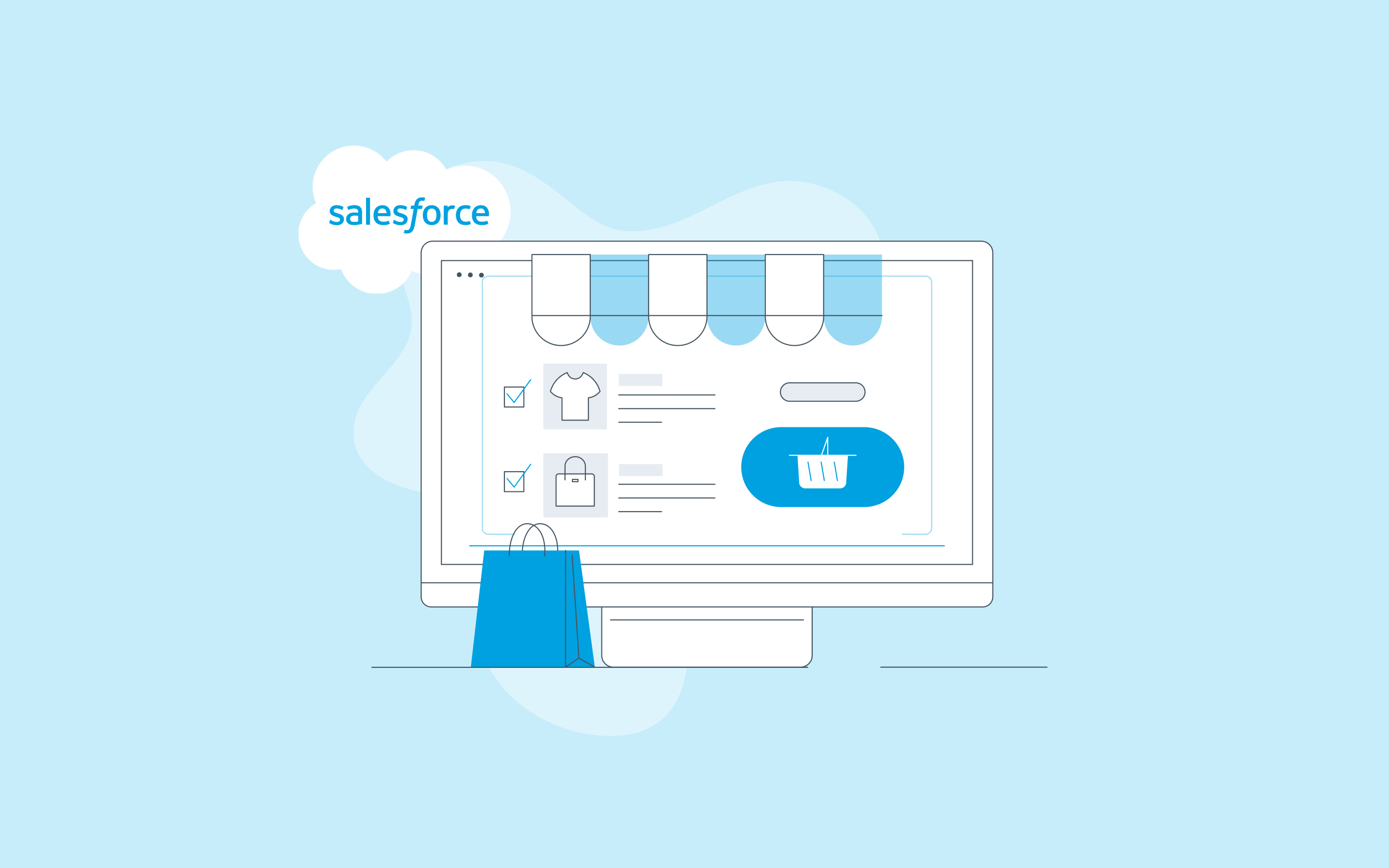

5 min read
•
Salesforce
•
August 8, 2025
Why Salesforce Commerce Cloud Is Still the Best Enterprise eCommerce Platform
SFCC in 2025: Enterprise Stability Meets Composable Flexibility
Salesforce Commerce Cloud (SFCC) has evolved from its Demandware roots into a modern enterprise platform capable of powering fully composable, headless storefronts. Today, leading brands pair SFCC’s robust backend with modern front-end frameworks like Next.js and Vercel and headless CMS platforms such as Contentstack or Amplience to unlock faster performance, better developer agility, and richer customer experiences.
64Labs is the global leader in composable SFCC builds, delivering projects for enterprise retailers such as Horizon Hobby, Moncler, Sweaty Betty, and Duluth Trading all with measurable performance and revenue gains.
A Quick History of SFCC
Salesforce acquired Demandware in 2016, gaining one of the most mature cloud-native commerce platforms on the market. At a time when competitors still relied on on-prem or heavily customised systems, Demandware offered scalability without infrastructure headaches.
While its CMS and search were limited in those early years, its stability, global readiness, and proven operational model made it the Porsche of eCommerce platforms - engineered for performance, enduring in design, and able to stay relevant as the world caught up.
What Salesforce Commerce Cloud Is Today
At its core, SFCC remains a stable, scalable SaaS commerce engine. It handles:
- Product catalog and pricing logic
- Promotions and inventory management
- Complex checkout workflows
- Multi-brand and multi-region orchestration
The real shift in recent years? SFCC now fits seamlessly into composable architectures, enabling brands to swap in best-of-breed tools while retaining a bulletproof commerce core.
From SiteGenesis to SFRA to Composable
- SiteGenesis – Legacy server-rendered architecture, fast for its time but inflexible and hard to maintain.
- SFRA (Storefront Reference Architecture) – Introduced modularity, responsive design, and cleaner code for the monolithic era.
- Composable Storefront – Built on modern JavaScript tooling with PWA Kit, SCAPI, and API-first integration, allowing front-ends on React or Next.js to be deployed on platforms like Vercel.
This evolution lets enterprise teams:
- Improve site performance dramatically
- Control their own front-end release cycles
- Integrate modern tools like Algolia for search or headless CMS for content
Why Composable SFCC Works for Enterprise Brands
Salesforce Commerce Cloud shines when:
- Running multi-brand portfolios with shared components
- Managing global pricing, tax, and inventory logic
- Integrating with complex ERP, CRM, and marketing stacks
- Passing stringent enterprise security and compliance requirements
When paired with a composable approach, SFCC gives brands backend stability and frontend freedom - the best of both worlds.
The Limits and How to Overcome Them
SFCC’s native CMS and search still lag behind best-in-class options. That’s why most of our composable builds integrate platforms like Amplience or Contentstack for content, and tools like Algolia for search.
Pricing can be a sticking point, but in 2025, negotiation flexibility is far greater - especially if you have the right partner guiding your roadmap.
Final Thoughts
Salesforce Commerce Cloud has come a long way since the Demandware days. It’s no longer just a managed backend for templated storefronts. It’s evolving into a flexible foundation for composable architectures, with room to plug in modern tools and scale globally.
For teams who need stability but don’t want to sacrifice flexibility, SFCC remains one of the few options that can support both. But to unlock its full potential, the architecture around it - including frontend, CMS, and integrations - needs to reflect modern composable thinking. And to get that, you need a partner that really lives this stuff. 64labs is far and away the leader in composable on SFCC. If you aren't being asked to bring us into conversations about your composable roadmap in some form someone isn't doing their job.
Thinking about building a composable storefront on Salesforce Commerce Cloud? We’ve helped some of the biggest names do it right. Let’s talk.
Read more

5 min read
•
July 15, 2025
AI & Automation
How AI Is Being Used in E-Commerce And Who’s Doing It Right
The Rise of AI in E-Commerce
AI has quickly become the shiny new object in e-commerce and, predictably, it’s now drowning in hype. Slide decks, vendor pitches, press releases; everyone’s tossing the term around. Who knows what people even mean by AI any more.
Sure, there are the inflated promises and buzzword bingo. But there are genuinely impactful ways AI is transforming online retail. It’s no longer limited to chatbots or basic personalization. Instead, AI is woven through content management, search, merchandising, fraud detection, customer service, and analytics. The potential payoff: smoother, faster, and deeply personalized customer experiences, alongside leaner, smarter operations for the business.
Yet, as usual, the theory is a lot prettier than the reality. Actual results on the ground remain uneven, and the hype often outruns the substance.
The truth is, AI-driven gains don’t materialize without the right digital foundation. If your infrastructure isn’t composable, structured, and ready to support rapid experimentation, AI won’t magically solve your problems—it’ll just create new ones that you won't be equipped to solve. The faster AI changes things, the further behind you will get.
Where AI Is Making a Measurable Impact
One of the clearest wins for AI in e-commerce has been search. Legacy keyword-driven systems often miss the intent behind what someone is actually trying to find. AI-powered search tools have stepped in to interpret that intent more effectively, serving results that align with what users mean, the context around their search, the behaviors that might illuminate the right response - not just what a user types. This leads to fewer dead-ends, less friction, and better conversion rates, especially on large catalogs.
Another area where AI has proven valuable is in content automation. AI-assisted copy, particularly translation, and increasingly image generation has started to help content teams scale campaigns faster without sacrificing cohesion. For brands with hundreds or thousands of SKUs, these tools can speed up product launches, landing page updates, and A/B testing strategies. It doesn't eliminate creative work - in fact you have to be somewhat more creative over time to get AI to do what you want - but it shifts the team’s focus to higher-impact content, the sort of thing you pay people their money for. AI isn't going to have a lot of original ideas. If you can't compete with that then the problem isn't AI.
Customer service has been the canary in the mine, with Chat being at the irritating vanguard of AI impact for multiple years now. Using AI to do routine ecommerce work today has all the frustrations you were giving customers two years ago when you thought Bots could replace your customer service agents - the forgetting things, the cheerful stupidity, the 'nearly but not quite' nature of their responses. But customer service is where to look to see how effective AI can be when it's well trained. How many times in the past few months have you interacted with a bot, wondered if it was a bot, and not asked because you didn't want to insult a human being. (For me: three times).
Generative AI is powering self-service layers that go beyond traditional FAQ bots. When properly trained on accurate business and order data, these models can help resolve common requests instantly, while escalating more complex issues to a human without losing the thread. That blend of automation and human handoff is pivotal in keeping costs down without degrading the customer experience. That's where the rubber is still making an unpleasant mark on the road. When I tell a bot my details and the human doesn't appear to have been given any of it, I'm mad. The humans and their systems are the problem now.
These gains, while sometimes incremental, add up. When AI is fully integrated into the architecture, it becomes a quiet performance multiplier. Teams move faster, experiences adapt to real user behavior, and internal data becomes more actionable. But you need a partner who understands how to put this all together, an engineering company. (Okay okay, get me a glass of water).
Where It Falls Apart
Despite all this, not every AI implementation delivers value. In fact, some create more problems than they solve.
A common issue is technical mismatch. Many organizations are trying to plug advanced AI tools into outdated platforms. If your e-commerce architecture is tightly coupled or monolithic, real-time personalization and AI-driven experiences will struggle to perform. The stack simply can’t handle the speed or complexity that modern AI tools require. You’ll end up with laggy site performance, inconsistent experiences, and frustrated teams. The silent part here is that if you're still on a "very" legacy version of your platform the problem might be that you don't run towards change. Get at least competent in managing the pace of technical change in our business or get rolled over.
Another problem is dirty or disjointed data. AI depends on clean inputs. When product data is incomplete, customer profiles are fragmented across systems, or tracking data is unreliable, the models being used won’t work well. This isn’t a tool issue, it’s an infrastructure issue. AI doesn't fix data problems. It magnifies them. You can't go to a trade show and buy something that does AI and hope that this solves your problems. You've got to start with a clear picture of what your capabilities are today, an honest one that acknowledges maybe you haven't changed as fast as you might have. Once you know your capabilities, know what you want to do. Focus on developing skills aggressively but incrementally, pushing and pushing for several months to develop greater understanding and ambition among your teams. Think of yourself 6 months from now and imagine AI actually can do something useful in early 2026. What needs to be true for you to take advantage? What will you wish you did now? Get on with it.
There’s also a strategic challenge. Many organizations adopt AI without a clear use case. They chase a trend, roll out an AI tool, and then wonder why it doesn’t move the needle. The ones who will see value are the ones that start with a specific outcome in mind (that picture of the world in 6 and 12 months is fuzzy, you are going to have to guess some of the details). Start with pain or greed. Pain? Do you need to reduce support costs. Pain: Improve search engagement. Greed: Could you increase campaign velocity. Then work backwards, match the skills and technology to the need and work out where to start. (Where you end up is too hard to predict. AI is developing too quickly.)
Lastly, AI is often introduced without a plan for internal ownership. So you start yourself a political AI death match at the very moment you need everyone to be working together. The most successful implementations happen when cross-functional teams are brought into the design process early. And when a small group of people get to deliver something real as a small cross-functional team. They develop trust. And that's the culture your AI initiatives will have. If only one department or one egomaniacal super-ambitious leader is responsible for your AI initiative, it not only becomes siloed, it becomes us versus them. If your best people are put in the trenches together and held accountable jointly for the first outputs, the extended team has a chance to see AI as a shared capability, it becomes part of how the business works.
What the Leaders Are Doing Differently
When I was at London Business School, I had this professor, Costas Markides. He had a book. I still have it and I think of it in every conversation we have at 64labs about innovation. The people who run the fastest at the start of an innovation wave are not always, in fact are rarely, the companies who benefit the most. (MySpace is the easiest to think about).
I had a sports editor and friend at the Sunday Times, Chris Nawrat. He was one of the smartest people I knew. He had this thing called the "Do Nothing" strategy. "John," he would say. "Sometimes the right thing to do is nothing. Let everyone else waste their energy, while think about what the possible end games might be and prepare for them instead." He survived at the Sunday Times the longest of any executive other than Andrew Neil.
So two questions. What's the end game of AI in your business do you think. What would Nawrat be preparing for? And does it matter if you arrive at the right answer on AI slightly after the initial discoverers have found it. Save some money. Plan rather than act.
The businesses who will win at AI aren’t necessarily spending more money or hiring more engineers. They’re structuring their teams and technology in ways that support process, clarity, simplicity. flexibility, speed, and interoperability. The sort of stuff that will mean they understand how best to apply AI in their business. Not actually rushing right away to the AI bit. Prepare.
And that's why composable should be on your agenda. If you adopt composable principles at an architectural level, give yourself the ability to test, refine, and scale new tools without refactoring your entire stack. Pay off technical debt urgently. You won't be able to service it in AI land. Invest in cleaning up and centralizing your data. Choose vendors based on their coherence and connectivity with the rest of your stack and your ability to use them as tools rather than products. Get some useful experience in an IT and content architecture where you get equal parts more power and more responsibility. But don't spend a lot of money on fancy consultants who barely know more about AI than you do. Build an internal coalition of the willing—people curious enough to figure out what works right now and committed enough to turn that learning into action. Let them develop just enough expertise to be dangerous when the end game starts. Then make sure they’re building the muscle to train others and evolve the tools internally, not just depend on vendors forever.
{{banner}}
What We’ve Learned
AI is absolutely going to shape the future of e-commerce in some way at some point. But right now it's either doing useful but banal work or it's a cute party trick. That will change quickly. But the quicker you admit you have no clue how it will affect your company exactly and start understanding the implications of that ignorance and what you can actually do about it for real, the better.
Those that approach AI thoughtfully, match it to real use cases, and modernize their infrastructure accordingly will see measurable returns. Those that treat it as a bolt-on feature or marketing bullet point will fall short. Not because the tools don’t work, but because the foundation wasn’t ready.
If you're serious about integrating AI into your customer experience, the first step isn’t to buy a new tool. It's to make sure your architecture, data, and teams are capable of supporting it.
Want a second opinion on whether your current stack is built to support modern AI tools? Let’s talk.

5 min read
•
July 15, 2025
Composable
Ecommerce
How Does Composable Help Marketers and Merchants
Your Digital Team is Better Than Your Tech Stack
Marketers and merchandisers in enterprise retail are often stuck in a weird paradox: they have powerful ideas, agile teams, and massive goals, but a tech stack that moves like it's 2012. If launching a promo takes 3 JIRA tickets and 2 weeks of dev time, you're not just behind, you're bleeding money.
Enter composable commerce: a modular, API-first approach to building digital storefronts. While it sounds like a developer’s dream (and it is), the biggest wins actually show up for marketers and merchants.
Here’s how.
1. You Can Get Sh*t Done Fast
Composable means your frontend is decoupled from your backend. So when merch or marketing wants to:
- Launch a campaign,
- Update a product carousel,
- Swap out homepage banners for seasonal offers,
- Build a landing page for that influencer collab…
...they can do it without dev involvement (or with minimal support). Teams can use low-code/no-code tools integrated into the stack (like CMSs or visual merch tools) to make changes in hours, not weeks. And dev teams, before you get too upset, these guys have been using tag managers and personalization tools behind your back to do things they shouldn't for about 10 years now. This is better-safer-transparenter than that.
Result: Faster go-to-market, more A/B testing, more wins.

2. Personalization and Segmentation Actually Work
Legacy monoliths often treat personalization like a bolt-on feature, not a core capability. Composable stacks let you plug in best-in-class personalization engines (we have hard-core expertise in or Dynamic Yield) that actually talk to your content and commerce layers in real-time.
Marketers can then:
- Target based on customer behavior, not just segments
- Trigger experiences dynamically
- Swap components (not entire pages)
Now, it better be built correctly by a partner who knows what they are doing. (cough). And that partner better be in the weeds with your team on what it has to do where (double cough). And you better be willing to out some work into making it work rather than think it automagically improves conversions (whooping cough). But a composable architecture does unlock all this.
Result: Better CX, higher conversion rates, more data to refine.
3. You Own the Brand Experience, Not the Platform
Composable gives you control over your frontend experience. Sure you have, like templates with like Bootstrap n stuff that you can play with. But repeat after me - ISML is DISML. With composable you are a world of React and Typescript and kittens. You get to control how the site looks, feels, and behaves instead of being locked into the templates someone thought were state of the art back in 2014.
This means your brand team can:
- Tell a story that actually feels premium
- Maintain consistency across channels
- Create immersive content experiences
…without getting a “that’s not possible with our CMS” reply from IT.
Result: Experience-driven commerce, not catalog-driven commerce.
4. Operational Flexibility = Less Burnout
Move fast and break stuff they say. Yeah, great advice for a 20 year old building an app no one wil likely ever have to use. We don;t get that luxury. Marketers and merchandisers are constantly caught between "move fast" and "absolutely don’t break stuff."
Composable gives us a middle ground:
- You can make changes and roll something back within about 10 seconds.
- Repair or update to one part of the site does not have to impact another. And you will have built testing and QA workflows to automatically make sure that is the case. Or at least you will if you use 64labs (cough - sorry I can;t quite get rid of this).
- You can schedule campaigns without syncing 5 different systems. Decide on your preferred workflow, how the various elements need to work together. And build that. Composable is made to compose.
- You can preview content as it will actually appear — not just in staging environments that look nothing like the real site.
Result: Less stress, more autonomy, more velocity, more control.
{{banner}}
5. No More Big Bang
Worried about an old school Big Bang launch of composable? Don't be. You can put a full composable site out to a subset of users for as long as you want before you have to commit ? Don’t be. Most enterprise teams go with a split launch - maybe 5% of users to start. They iron out any kinks. Then when they realize how much the ROI will be if they switch over like right now, they switch.
You can go incremental of course.
You can plug in a headless CMS (like Contenstack or Amplience), run it headlessly within your legacy stack for a while, and prove ROI before ripping anything out. Or un composable with a new CMS in one region for six months to give yourselves some experience of both before rolling out globally.
Result: Low risk, high reward — easy to minimize risk and you keep IT on your side.
In a world where campaigns move at the speed of culture and conversion windows last minutes, composable lets marketers and merchandisers do what they do best: create, launch, measure, and optimize without waiting for devs, approvals, or outdated systems to catch up.

5 min read
•
July 15, 2025
Composable
Ecommerce
Monolithic vs. Composable Commerce: Which One Actually Lets You Move
Monolithic commerce platforms still dominate the legacy install base. But composable architecture is quietly and quickly becoming the default for brands that want to move fast, personalize better, and scale smart. Here’s why.
Two Paths. One Direction That Matters.
At some point, every digital team hits the same wall: is your commerce platform pushing you forward, or is it quietly holding you back?
Monolithic platforms are familiar. Everything in one place. One contract, one vendor, one roadmap to follow. That made sense when stability was the goal. But the game has changed.
Composable commerce is built for movement. It splits the stack into parts—CMS, search, checkout, personalization—and connects them through APIs. So each part of your business can evolve on its own terms.
This isn’t a backend engineering preference. It’s a strategic foundation for shipping faster, experimenting more, and building digital experiences that keep up with the customer.
{{banner}}
Why Composable is Pulling Ahead
Modern brands move on short timelines. Product drops, geo-expansion, A/B tests, loyalty programs, AI-driven content—none of that fits neatly inside the old dev cycle.
Monolithic platforms slow things down. One small update means full regression testing. Teams queue up behind each other. Deadlines slip. Innovation fades.
Composable fixes that. You want to try a new CMS? Plug it in. Want to update the frontend? Do it without touching the checkout. Want to test two search vendors? Go for it.
Decoupled systems let every team move at their own pace. No more waiting for a single system to catch up.
{{banner}}
Tradeoffs Worth Knowing
There are still situations where a monolith makes sense. Simpler teams, tighter budgets, fewer moving parts. If your business needs one site and one language, all-in-one can be fine.
But once you scale, that simplicity becomes a constraint. You’ll find yourself spending more time working around the platform than improving your experience.
Composable takes more planning upfront. You need to pick tools, define APIs, structure your stack. But once it’s in place, you’re in control. Not locked to a vendor’s roadmap. Not bottlenecked by a bundled release schedule.
What It Looks Like Day to Day
Say your team wants to relaunch the site, overhaul search, add personalization, and expand to three new countries. And marketing still needs to push campaigns live weekly.
In a monolithic setup, that’s a six-month program with a lot of dependencies and delays.
In a composable world, content updates go through the CMS, personalization gets tested in isolation, and the frontend evolves alongside the rollout. Each stream moves independently. That means fewer collisions and more shipping.
The Wrap
Monolithic platforms had their moment. And for some teams, they’re still good enough. But if your brand is growing, diversifying, or trying to accelerate, composable is probably the better fit.
It gives your teams control. It frees you from outdated timelines. And it lets your tech stack evolve with the business, not behind it.
Let’s Talk. If you’re wondering what composable could unlock for your business, We’d be happy to show you.
